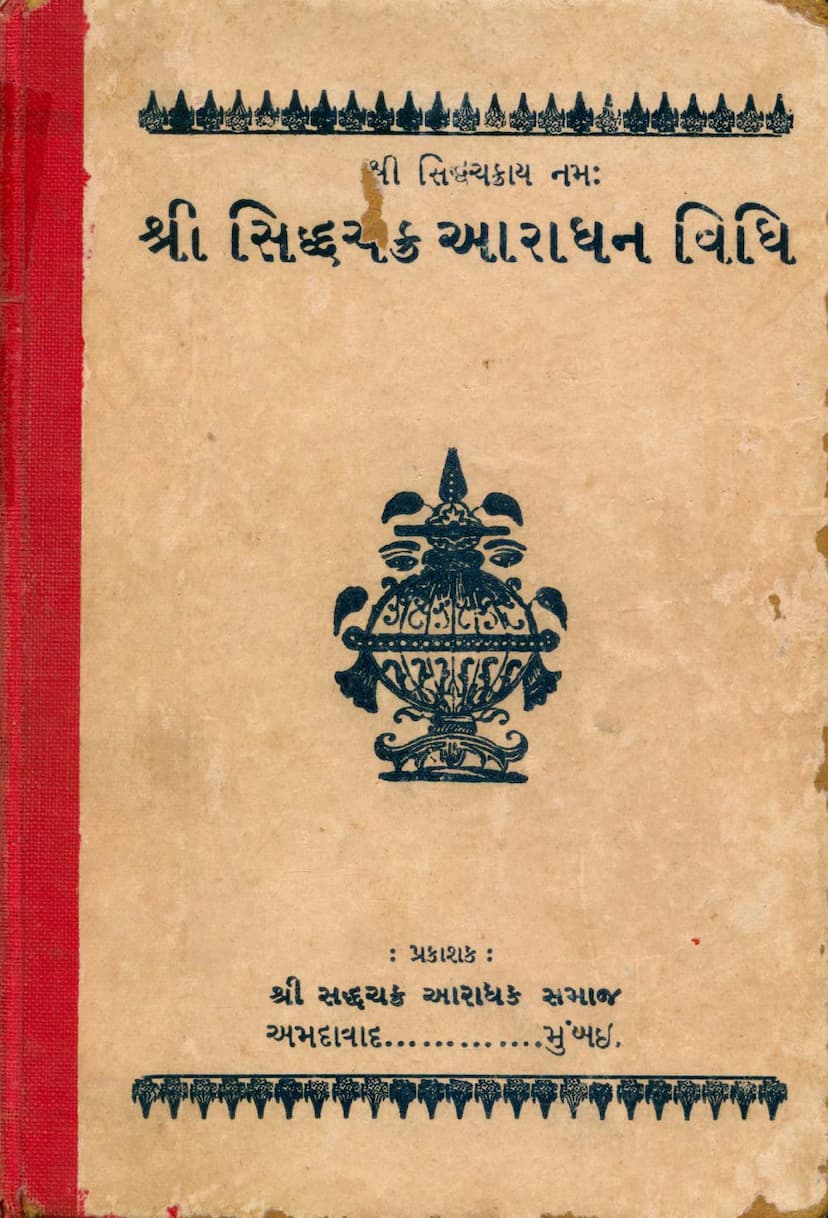Siddhachakra Aradhana Vidhi
Added to library: September 2, 2025

Summary
This comprehensive summary outlines the Jain text "Siddhachakra Aradhana Vidhi," authored by Siddhachakra Aradhak Samaj and published by the same organization. The book is a detailed guide to performing the "Siddhachakra Aradhana," a significant ritual in Jainism.
The text is divided into five main sections, covering various aspects of the aradhana:
Section 1: The Greatness of Siddhachakra, Ritual Procedures, and Instructions This section introduces the Siddhachakra (Nine-Jewel) concept, emphasizing its importance as a path to spiritual liberation. It explains how the nine celestial entities—Arhant, Siddha, Acharya, Upadhyaya, Sadhu, Samyak Darshan (Right Faith), Samyak Gyan (Right Knowledge), Samyak Charitra (Right Conduct), and Tap (Austerity)—collectively represent Dev (God), Guru (Teacher), and Dharma (Religion). The aradhana is presented as a cyclical representation, with the Arhant deity at the center, surrounded by eight petals forming a lotus, symbolizing the Siddhachakra itself. This practice is believed to grant all desires and bestow auspicious Ladhis (supernatural powers). The section also provides essential guidelines and instructions for those undertaking the aradhana.
Section 2: Praises, Chaityavandanas, Stotras, and Thas This part focuses on devotional recitations and rituals. It includes various stotras (hymns of praise) dedicated to Jinendra (Tirthankaras), chaityavandanas (venerations of Jain temples and idols), stotras, and thas (short devotional poems or songs) that are recited during the nine-day aradhana.
Section 3: Snatra Pujas and Various Other Pujas This section details different types of pujas (worship rituals). It includes:
- Snatra Pujas: Elaborate bathing rituals performed for deities, with specific pujas attributed to renowned Jain scholars like Pandit Devchandji and Kavi Virvijayji.
- Navpad Pujas: Worship ceremonies dedicated to each of the nine fundamental principles of Jainism, attributed to scholars like Yashvijayji and Padm vijayji.
- Sattar Bhedi Puja: A worship ritual encompassing seventeen categories of offerings or devotional acts.
- Chosath Prakari Puja: A worship ritual involving sixty-four types of devotional practices.
- Panchkalyanak Puja of Lord Mahavir: A specific puja commemorating the five auspicious events in the life of Lord Mahavir.
- Ashta Prakari Puja: A worship ritual involving eight types of offerings, attributed to Devvijayji.
- Shanti Kalash: Rituals for peace and well-being.
Section 4: Padas, Sajhaya, Garba, Lavani, Stavana, Aartis, and Mangal Deep This section covers a variety of devotional songs and performances:
- Padas: Devotional verses.
- Sajhaya: Religious songs, often with moral teachings.
- Garba: Devotional folk songs, often performed in a circular dance.
- Lavani: A type of folk song.
- Stavana: Hymns of praise.
- Aartis: Ritualistic waving of lamps before deities.
- Mangal Deep: Auspicious lamps lit as part of the worship. The section includes specific examples related to Navpad, Shantinath, and Aadinath.
Section 5: Chaitri Purnima Devavandan Ritual and Others This final section focuses on the devotional practices performed on Chaitri Purnima (the full moon day of the Chaitra month). It includes the specific ritual for Devavandan (veneration of deities) on this auspicious day, along with related stotras. Additionally, it provides tables for determining the times for breaking fasts (Navkarshi, Parsik, Sadharsai, Purim Adhvadh) and concludes with auspicious blessings.
Key Themes and Concepts:
- Siddhachakra (Navpad): The central theme, representing the nine supreme entities in Jainism and the path to liberation.
- Arahana: The ritualistic worship and devotion towards these nine entities.
- Mahaatmya: The text emphasizes the spiritual and material benefits derived from performing the aradhana, including spiritual advancement, wealth, prosperity, and ultimately, moksha (liberation).
- Vidhi: Detailed procedural instructions are provided for each ritualistic act.
- Devotion and Bhakti: The text highlights the importance of pure intention, devotion, and proper observance of rituals.
- Spiritual Upliftment: The aradhana is presented as a means to purify the soul, overcome karma, and attain spiritual realization.
The book serves as a practical manual for Jain devotees seeking to perform the Siddhachakra Aradhana with correct procedures and devotion, drawing from established Jain traditions and scholarly contributions.